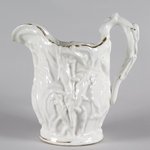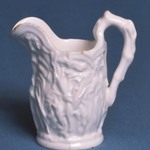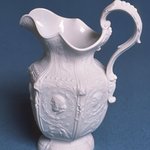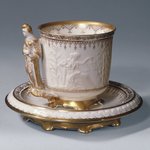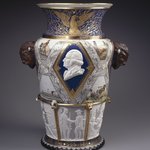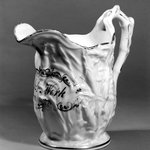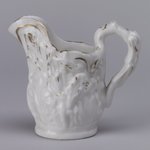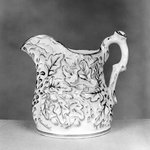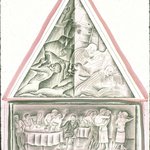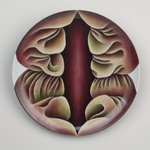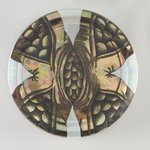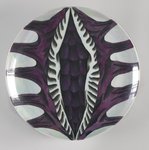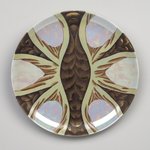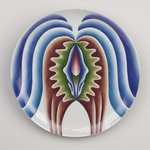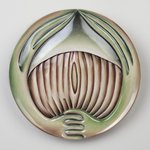

Download our app and ask your own questions during your visit. Here are some that others have asked.
Were the names on the floor tiles in The Dinner Party written before or after the tiles were fired?
I believe the names were applied under the glaze. The tiles were handmade in Los Angeles.
Wow!
Do you know if there is any patten in the names written on the floor in the middle of all the tables?
So few people notice the names on the Heritage Floor! There is a pattern to the 999 names. They were each selected to relate to the main figures at the table and they flow out from the place settings in streams.
Thanks.
Who is Lydia?!
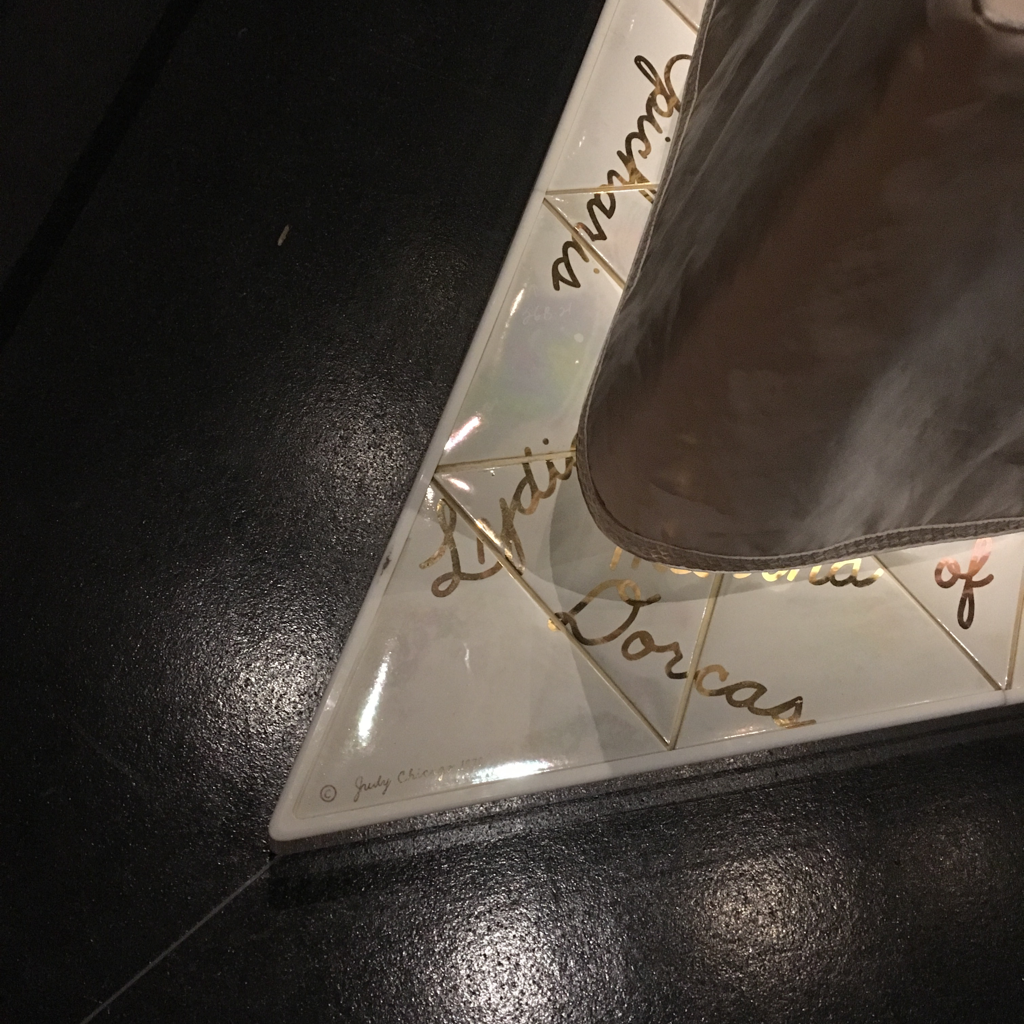

Lydia was a wealthy merchant from the kingdom of Lydia (modern day Turkey). She ran a business that produced purple dye, a color worn by royals and the upper class, and highly prized. Lydia's story is part of the New Testament of the bible, because she was hospitable to Saint Paul and his followers.
My name is Julia so I want to know about Julia!
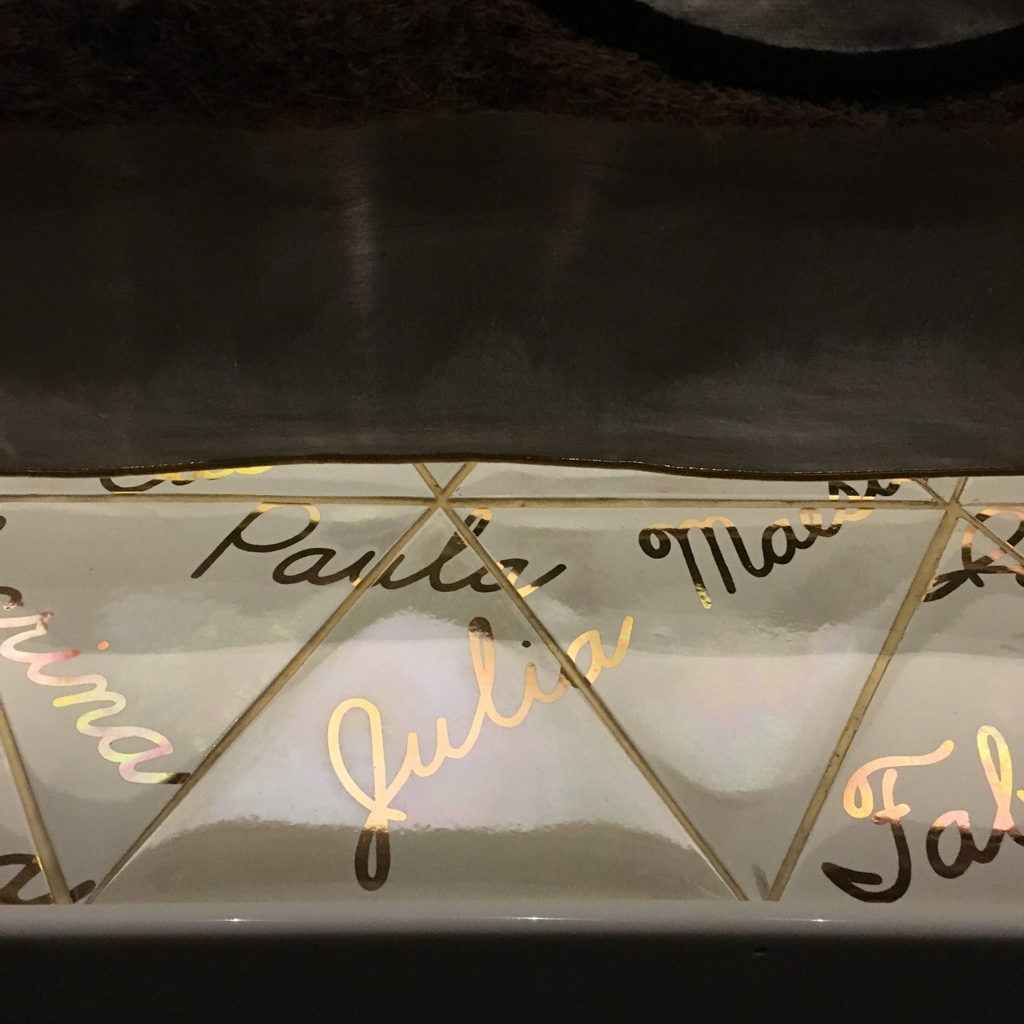

There are actually several Julia's on the heritage floor. Julia Domna was a Syrian woman born around 170 CE, who was eventually married to the Roman emperor Septimus Severus. She was known for being wise and politically minded.
Julia Maesa, the one you photographed, was likely Julia Domna's younger sister.
I'm so interested in them!
Same! One of my favorite biographies of the women around The Dinner Party is that of Theodora, another woman who married an emperor and went on to use her political power to influence women's lives.
When "The Dinner Party" exhibit has been moved around in the past, how has the Heritage Floor been transported?
Like with most very large-scale works of this nature, the whole thing has to be dismantled, shipped, and reassembled. The Heritage Floor could be broken down into sections.
The space that "The Dinner Party" occupies now was purpose-built for the work. It keeps the work safe and also makes it appear more permanent.
Wow, thank you.
Who is Pandora?


In ancient Greek myth, she was the first woman created by the gods.
The king of the gods gave her a special jar (often translated as a box in modern literature) as a wedding gift and told her never to open it. She was curious and so she disobeyed. When she opened it, it released evil spirits that flew into the world and created all its problems.
So she has been blamed for a lot!
Sounds a lot like Eve.
There are a lot of parallels between Pandora's and Eve's stories! Many Biblical stories have clear origins in the mythology of the ancient Mediterranean, especially Mesopotamia and Egypt. There were also many similarities across these cultures in ancient times.
Chicago was interested in bringing women back into history, because she felt that she hadn't learned anything about women's contributions to history and culture and science when she was in school.
How many of the 999 women on the Heritage Floor are of color?
On the Heritage Floor, I believe there are 18 African-American women, 1 African woman, 20 people indigenous to the Americas (including 5 mythical), 21 Latinx women, 1 woman from the Pacific, and 3 Moorish women.
There are many names from the ancient Near East who we might consider people of color today, but were likely not thought of that way in the 1970s.
Any woman athletes on the tiles?
It doesn't look like there are any athletes. There are a few dancers, Isadora Duncan, Marie Sallé, Martha Graham, and ballerina Anna Pavlova,
Is there any symbolism behind the handwriting on the floor panels? Asking for a friend.
The handwriting itself is based on Judy Chicago's own handwriting. There are 999 names grouped into streams flowing out from each place setting. The groups are thematic.
These 999 additional women also symbolize, conceptually, the multitudes that have been lost to history.
Thank you.
It intrigues me that the lid of the piano becomes a vaginal metaphor. Hmm. I see Clara Schumann is right at the edge of the floor. Is Nannerl Mozart also nearby?
The names on the floor relate to the place settings they are near so it makes sense to find Schumann, another composer, by the piano-plate of Ethyl Smyth. As for Nannerl Mozart, she is not included.
I have a background in music so I'm more aware of the possible names that could have been included here. It’s a little like a concentrated archaeological expedition, isn’t it? It makes me sad and angry that so much has NOT been preserved or remembered.
Thanks for your answers.
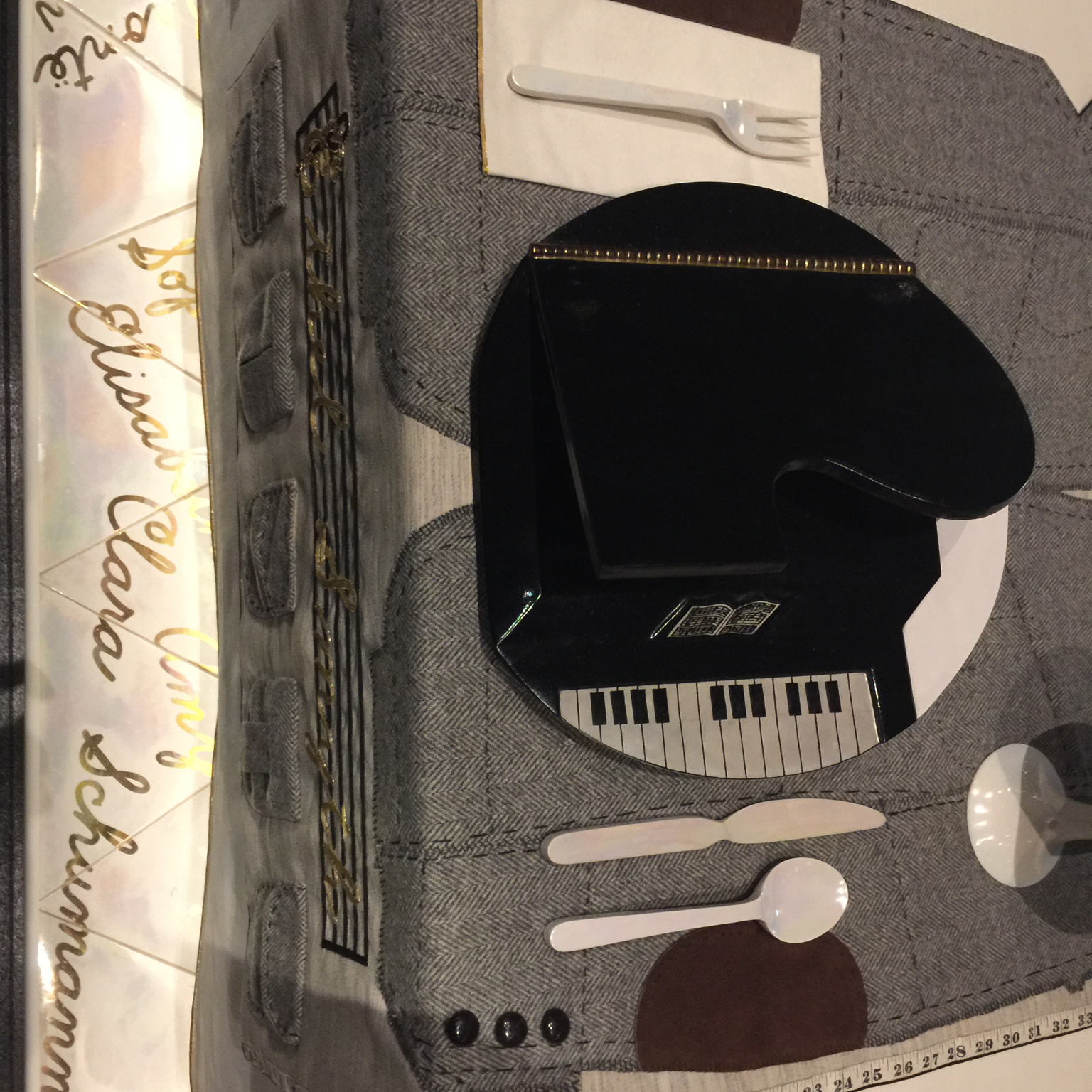

Yes, as much as the research team behind The Dinner Party uncovered names of artists who didn't get their due recognition, there are still many more who have been left out of history.
What do the words on the floor tiles represent?
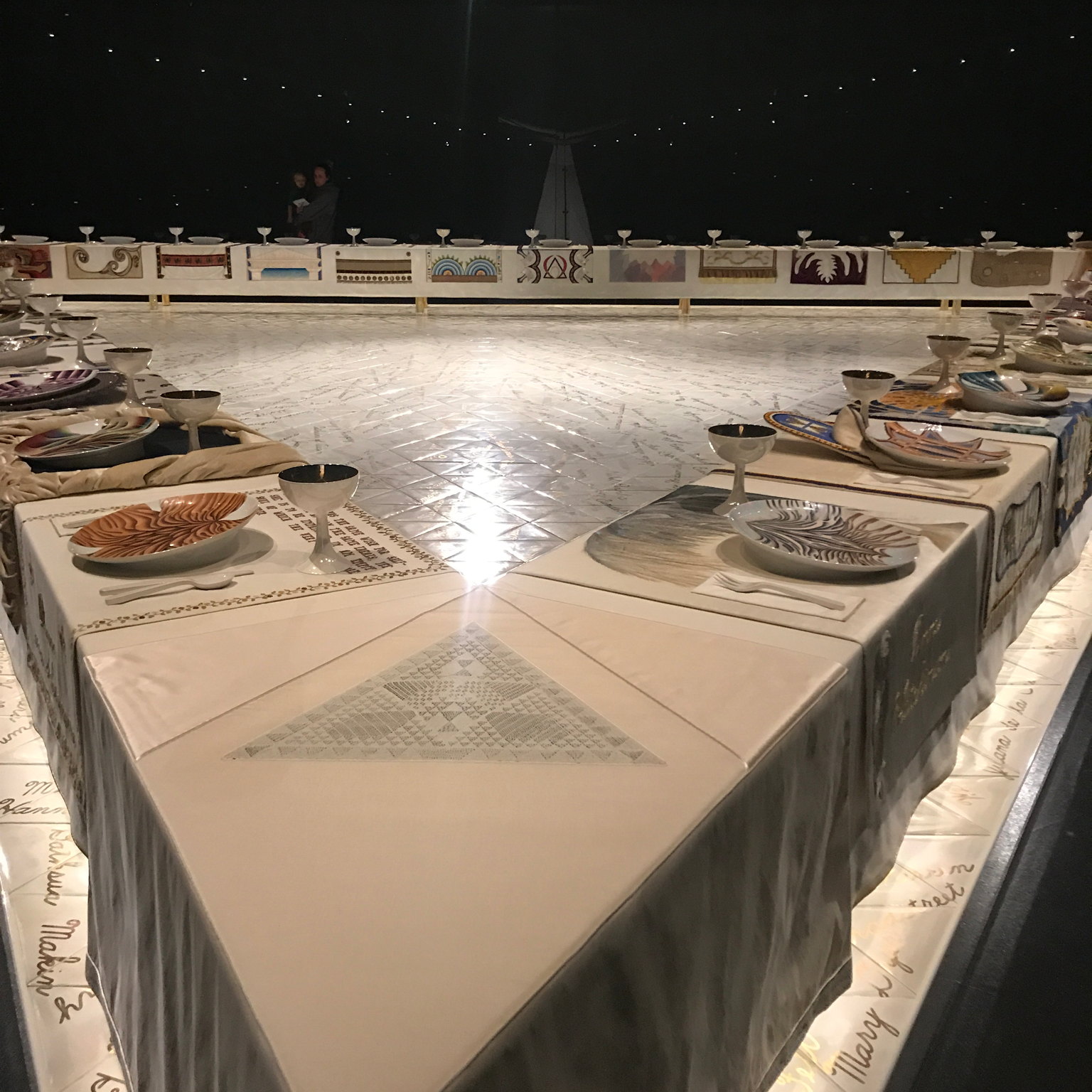

Those are more names! There are 39 place settings at The Dinner Party and another 999 women's names on the Heritage Floor.
They represent more women who have made contributions to history and their number stands for the multitudes of women who have been forgotten to history.
Wow. Thank you.
Is there a plate for Rachel Carson
in The Dinner Party?
Carson does not have her own plate, but you can find her name on the Heritage Floor near the place setting for Margaret Sanger.
I'm glad her name is included at least since she was the mother of the environmental movement!
One question we had about the Dinner Party - totally different but perspective is making us think this - any information on Kresilas? The person the description said was a man?
That's actually an interesting example. In the 19th century, Kresilas was misidentified by historians as "Cresilla"
Kresilas was a male, Greek sculptor, but for a time Historians mistook him for a woman and wrote about him as such. When Chicago was crafting the Dinner Party, he was still being mislabeled as a woman.
So you're right, perspective changes so much on this artist depending on the gender we assume them to be.
The opposite is true of another figure depicted in the dinner party: Hatshepsut. Hatshepsut was a female Egyptian pharaoh, but was visually depicted as a male in Egyptian sculpture due to stringent artistic conventions on how to depict rulers.
So in that case we have a woman once mistaken to be a man, while Kresilas is a man once mistaken to be a woman. Our readings of them may then change depending on which gender we read them as.
Thanks that’s fascinating! You really deepened our understanding.
Where can I find Frida Kahlo in The Dinner Party?
Kahlo's name appears on the Heritage floor tiles near the place setting for Georgia O'Keeffe. While Kahlo was celebrated and exhibited during her life---including an exhibition at the MoMA in the 1930s---by the 1970s, when Judy Chicago was creating The Dinner Party, Kahlo had been largely excluded from the art history canon.
Chicago was first made aware of Kahlo's work by her friend Arlene Raven in a letter sent while Chicago was travelling in Mexico. Then, a retrospective of Kahlo's work at MCA Chicago in 1978 sparked wider knowledge of her work, especially among feminists. Judy Chicago later wrote a book reflecting on Kahlo's work, published in 2010.
Can you tell me more about Semiramis?
Semiramis was a queen of Assyria. Most of her biography is known only from legends: the daughter of a fish goddess, she married King Ninus of Babylon, then took control and had him executed.
According to legend, she had many lovers, most of whom she eventually had killed. When her son succeeded her on the throne, he then had her killed. A rather violent story all around, I'm afraid.
However, Semiramis was also known for encouraging a building program in Babylon, and she supported a military campaign to conquer nearby cities.
I've just found some more concrete history, slightly less legendary...
She was also known as Sammu-Ramat, and she ruled from 811-806BCE while her son was still too young to take the throne.
Floor Tiles
Judy Chicago
Elizabeth A. Sackler Center for Feminist Art
On View: Elizabeth A. Sackler Center for Feminist Art, 4th Floor
MEDIUM
Porcelain
DATES
1974–1979
COLLECTIONS
Elizabeth A. Sackler Center for Feminist Art
ACCESSION NUMBER
2002.10-FT
CREDIT LINE
Gift of The Elizabeth A. Sackler Foundation
MUSEUM LOCATION
This item is on view in Elizabeth A. Sackler Center for Feminist Art, 4th Floor
RECORD COMPLETENESS
Not every record you will find here is complete. More information is available for some works than for others, and some entries have been updated more recently. Records are frequently reviewed and revised, and we welcome any additional information you might have.


Download our app and ask your own questions during your visit. Here are some that others have asked.
Were the names on the floor tiles in The Dinner Party written before or after the tiles were fired?
I believe the names were applied under the glaze. The tiles were handmade in Los Angeles.
Wow!
Do you know if there is any patten in the names written on the floor in the middle of all the tables?
So few people notice the names on the Heritage Floor! There is a pattern to the 999 names. They were each selected to relate to the main figures at the table and they flow out from the place settings in streams.
Thanks.
Who is Lydia?!


Lydia was a wealthy merchant from the kingdom of Lydia (modern day Turkey). She ran a business that produced purple dye, a color worn by royals and the upper class, and highly prized. Lydia's story is part of the New Testament of the bible, because she was hospitable to Saint Paul and his followers.
My name is Julia so I want to know about Julia!


There are actually several Julia's on the heritage floor. Julia Domna was a Syrian woman born around 170 CE, who was eventually married to the Roman emperor Septimus Severus. She was known for being wise and politically minded.
Julia Maesa, the one you photographed, was likely Julia Domna's younger sister.
I'm so interested in them!
Same! One of my favorite biographies of the women around The Dinner Party is that of Theodora, another woman who married an emperor and went on to use her political power to influence women's lives.
When "The Dinner Party" exhibit has been moved around in the past, how has the Heritage Floor been transported?
Like with most very large-scale works of this nature, the whole thing has to be dismantled, shipped, and reassembled. The Heritage Floor could be broken down into sections.
The space that "The Dinner Party" occupies now was purpose-built for the work. It keeps the work safe and also makes it appear more permanent.
Wow, thank you.
Who is Pandora?


In ancient Greek myth, she was the first woman created by the gods.
The king of the gods gave her a special jar (often translated as a box in modern literature) as a wedding gift and told her never to open it. She was curious and so she disobeyed. When she opened it, it released evil spirits that flew into the world and created all its problems.
So she has been blamed for a lot!
Sounds a lot like Eve.
There are a lot of parallels between Pandora's and Eve's stories! Many Biblical stories have clear origins in the mythology of the ancient Mediterranean, especially Mesopotamia and Egypt. There were also many similarities across these cultures in ancient times.
Chicago was interested in bringing women back into history, because she felt that she hadn't learned anything about women's contributions to history and culture and science when she was in school.
How many of the 999 women on the Heritage Floor are of color?
On the Heritage Floor, I believe there are 18 African-American women, 1 African woman, 20 people indigenous to the Americas (including 5 mythical), 21 Latinx women, 1 woman from the Pacific, and 3 Moorish women.
There are many names from the ancient Near East who we might consider people of color today, but were likely not thought of that way in the 1970s.
Any woman athletes on the tiles?
It doesn't look like there are any athletes. There are a few dancers, Isadora Duncan, Marie Sallé, Martha Graham, and ballerina Anna Pavlova,
Is there any symbolism behind the handwriting on the floor panels? Asking for a friend.
The handwriting itself is based on Judy Chicago's own handwriting. There are 999 names grouped into streams flowing out from each place setting. The groups are thematic.
These 999 additional women also symbolize, conceptually, the multitudes that have been lost to history.
Thank you.
It intrigues me that the lid of the piano becomes a vaginal metaphor. Hmm. I see Clara Schumann is right at the edge of the floor. Is Nannerl Mozart also nearby?
The names on the floor relate to the place settings they are near so it makes sense to find Schumann, another composer, by the piano-plate of Ethyl Smyth. As for Nannerl Mozart, she is not included.
I have a background in music so I'm more aware of the possible names that could have been included here. It’s a little like a concentrated archaeological expedition, isn’t it? It makes me sad and angry that so much has NOT been preserved or remembered.
Thanks for your answers.


Yes, as much as the research team behind The Dinner Party uncovered names of artists who didn't get their due recognition, there are still many more who have been left out of history.
What do the words on the floor tiles represent?


Those are more names! There are 39 place settings at The Dinner Party and another 999 women's names on the Heritage Floor.
They represent more women who have made contributions to history and their number stands for the multitudes of women who have been forgotten to history.
Wow. Thank you.
Is there a plate for Rachel Carson
in The Dinner Party?
Carson does not have her own plate, but you can find her name on the Heritage Floor near the place setting for Margaret Sanger.
I'm glad her name is included at least since she was the mother of the environmental movement!
One question we had about the Dinner Party - totally different but perspective is making us think this - any information on Kresilas? The person the description said was a man?
That's actually an interesting example. In the 19th century, Kresilas was misidentified by historians as "Cresilla"
Kresilas was a male, Greek sculptor, but for a time Historians mistook him for a woman and wrote about him as such. When Chicago was crafting the Dinner Party, he was still being mislabeled as a woman.
So you're right, perspective changes so much on this artist depending on the gender we assume them to be.
The opposite is true of another figure depicted in the dinner party: Hatshepsut. Hatshepsut was a female Egyptian pharaoh, but was visually depicted as a male in Egyptian sculpture due to stringent artistic conventions on how to depict rulers.
So in that case we have a woman once mistaken to be a man, while Kresilas is a man once mistaken to be a woman. Our readings of them may then change depending on which gender we read them as.
Thanks that’s fascinating! You really deepened our understanding.
Where can I find Frida Kahlo in The Dinner Party?
Kahlo's name appears on the Heritage floor tiles near the place setting for Georgia O'Keeffe. While Kahlo was celebrated and exhibited during her life---including an exhibition at the MoMA in the 1930s---by the 1970s, when Judy Chicago was creating The Dinner Party, Kahlo had been largely excluded from the art history canon.
Chicago was first made aware of Kahlo's work by her friend Arlene Raven in a letter sent while Chicago was travelling in Mexico. Then, a retrospective of Kahlo's work at MCA Chicago in 1978 sparked wider knowledge of her work, especially among feminists. Judy Chicago later wrote a book reflecting on Kahlo's work, published in 2010.
Can you tell me more about Semiramis?
Semiramis was a queen of Assyria. Most of her biography is known only from legends: the daughter of a fish goddess, she married King Ninus of Babylon, then took control and had him executed.
According to legend, she had many lovers, most of whom she eventually had killed. When her son succeeded her on the throne, he then had her killed. A rather violent story all around, I'm afraid.
However, Semiramis was also known for encouraging a building program in Babylon, and she supported a military campaign to conquer nearby cities.
I've just found some more concrete history, slightly less legendary...
She was also known as Sammu-Ramat, and she ruled from 811-806BCE while her son was still too young to take the throne.
